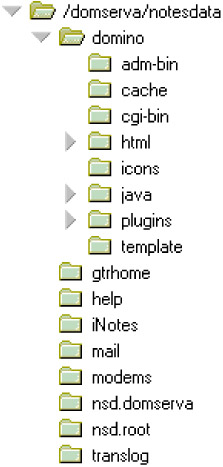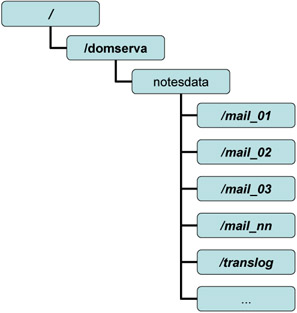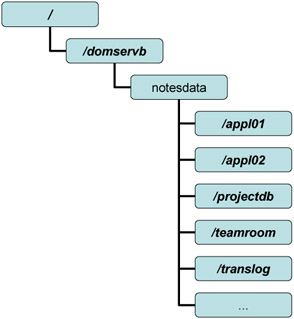4.5 Domino filesystem structure
|
| < Day Day Up > |
|
4.5 Domino filesystem structure
To understand where to place the files of your Domino server, you have to understand which files the server uses and what they are good for. By default, all files are placed under the notesdata directory-some in dedicated directories, and others directly in notesdata.
The most important files for a Domino server are the ID file (server.id), the configuration file (notes.ini), and the Domino Directory (names.nsf). Those files are typically placed directly in the notesdata directory. Figure 4-3 shows a typical directory structure of a Domino server.

Figure 4-3: Domino directory structure
For the files that hold the application and mail data, you should use dedicated directories. Figure 4-3 shows this for the mail directory. From the start it is a good idea to have the notesdata directory, the mail directory, and the translog directory as separate mount points with separate volumes for each attached. In the following sections, we discuss in more detail the placement of files and databases. Of course, not only the data files go into the notesdata directory and below; all files related to the code (executables, libraries, and so on) go under the /opt/lotus directory, by default.
4.5.1 Mount points and Domino
| Tip | Whenever a mount point is created for Domino, the owner and group of the mount point must be changed to be the correct owner and group for that mount point. For example, if the mount point is to be used by "domserva" and is part of the group "notes," then execute the following:
chown -R domserva:notes <mount point> |
Proper planning of the mount points can have a significant effect on the manageability of Linux and the Domino server. For Domino, we recommend you create at least three filesystems or mount points for the Domino server: one for the binaries (/opt/lotus), a second for the notesdata directory (.../notesdata), and a third for the directory holding the actual users or application databases (.../mai01 or .../apps01).
Normally you will want to have additional mount points so that you can structure your Domino data in more detail. Figure 4-4 and Figure 4-5 on page 64 illustrate the relationship of mount points to the directories in two types of Domino servers. The directories in bold and italics indicate that these are separate mount points.

Figure 4-4: Example mount point (filesystem) structure for a mail server

Figure 4-5: Example mount point structure for an application server
Figure 4-4 shows an example of the structure of the Domino filesystem. We do not show all the directories that might occur in a productive Domino server. The figures focus on the mount points and on the naming convention for the directories.
The directory domserva is the first mount point for Domino. The notesdata directory is a directory under domserva and within the domserva mount point. The directories mail_01, mail_02, mail_03, mail_nn are also separate mount points, as is translog. Other directories can exist under notesdata, in addition to the mail_xx and translog directories.
For an application server, the structure might look more like Figure 4-5 on page 64. Before making decisions on where to place your mount points, read the following sections about Domino databases and Domino-related files and where they can be placed.
|
| < Day Day Up > |
|
EAN: 2147483647
Pages: 162